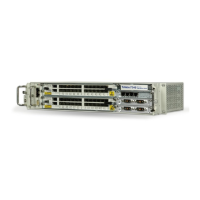3. System Architecture System Manual
Page 2-14 8/09 76.7300FP11/2, Rev A
Switched Ethernet Services and Features
3.03 Service providers are enhancing their Ethernet networks to address the
combination of residential triple play services and business services in a single
network. Traditional Ethernet bridging is based on sending traffic to all ports
connected to a switch. This works in a LAN environment, but as the number of
ports increases, the traffic expands to a point where the network is overwhelmed.
3.04 With the need to deliver residential triple play services and business
services over a converged network, the ability to guarantee bandwidth and
end-to-end service performance becomes a necessity. Traditional enterprise
Ethernet and pure-IP options do not provide these bandwidth and end-to-end
service performance guarantees.
3.05 Guarantees allow service providers to establish different classes of service
level agreements for multiple types of traffic from multiple types of customers. This
can include residential or business customers with best effort or guaranteed
low-latency/high availability traffic for Internet access, video, or voice traffic.
3.06 The tools for enabling these agreements include aggregate flow control
level policing at the ingress of a network, shaping at the egress of a network, and
priority queuing throughout the network.
3.07 Extensions have been created to increase the scalability of Ethernet
networks by allowing partitioning of the network. The first extension was the virtual
LAN (VLAN) with an identifying tag. Traffic arriving at a port on a switch with a
particular VLAN is flooded only to the other ports in the switch associated with this
tag. Since the tag field was 12-bits, up to 4096 VLANs could be supported in a
network. A second extension has been added to increase the VLAN space by
separating operator VLANs from customer VLANs. The Provider Bridging
standard, 802.1ad, defines using multiple VLAN tags per frame within a network to
provide this separation and increase the VLAN space to 4096 by 4096.
Quality of Service (QoS)
3.08 The QoS service policy directs the switch on the method to handle packets
that are received by the interface. The service policy is associated with each
Ethernet interface.
QoS Services 3.09 The QoS features available on the switch provides the following services:
• Congestion management
• Traffic marking
• Traffic shaping and policing
• Traffic scheduling
• Ability to handle differential services and queuing requirements

